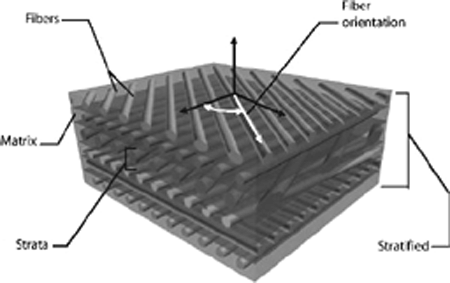4.6. Applications on composite materials
In the past few years, composite materials have received renewed interest, principally because of their mechanical performance/weight compromise. These materials slowly replace classical materials in the aeronautical and automotive industries.
In this section, we will tackle the non-destructive control of composite materials by the thermo-inductive method. Using the calculation code, a parametric study will be conducted to identify and improve the technique’s performance. Based on the obtained results and to complete the study, general practical guidelines will be elaborated in order to make the technique more accessible for an eventual integration into an industrial process.
Figure 4.40. Stratified composite

4.6.1. Study of composite materials
A composite material is a combination of fibers and materials with different mechanical and thermal characteristics. Combining both materials brings distinct properties to the composite material, and moves its performances superior to those of its separate components (Figure 4.40). Because of their advantages, the field of application of composite materials is large and continues to develop in many industrial sectors, essentially in the aeronautical and automotive sectors. The main qualities of composite materials are the increase in lifetime, ease of product design, weight, and safety. They can ...
Get Electrothermics now with the O’Reilly learning platform.
O’Reilly members experience books, live events, courses curated by job role, and more from O’Reilly and nearly 200 top publishers.

